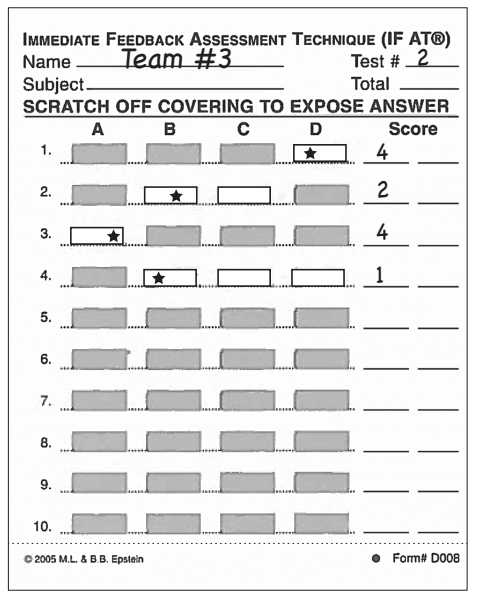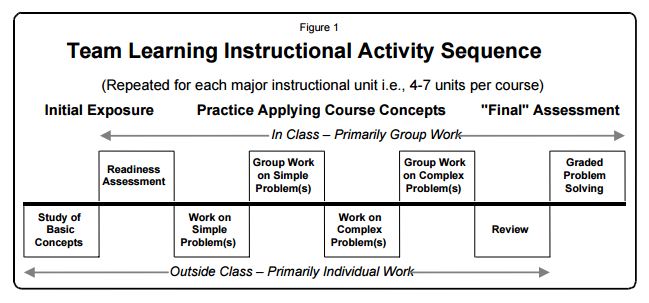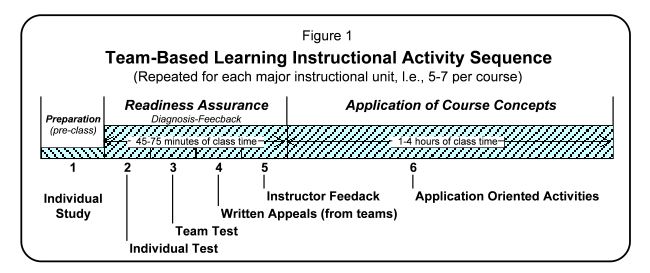Team-Based Learning
Team-based Learning (TBL) is a course design framework that:
- Fosters collaborative learning
- Follows a specific sequence
- Readiness Assurance Process (RAP)
- In-class Activities (practice)
- Is a paradigm shift from learning the threshold concepts to applying these via problem-solving
-
- Better utilizes faculty/instructor expertise
- Getting Started With TBL
Design Resources
- Team-Based Learning Collaborative
- Go to the Getting Started tab at the top of the page
- Numerous other resources available on this site
- Overview of TBL – 12 min video
- Essentials of TBL
- TBL Handout
- TBL Texts
- Team Formation
TBL Framework
- Is designed in 3-8 class meeting chunks or modules
- Each chunk/module consists of:
- Readiness Assurance Process (RAP)
- Pre-Class
- Readings, observations, and other activities focused on the threshold concepts
- In Class
- Immediate Feedback Assessment Technique (IF-AT) enable partial credit (see image below)
- Individual Readiness Assessment Test (iRAT) is a multiple-choice test utilizing Bloom's Taxonomy (revised) bottom 3 levels
- Team Readiness Assessment Test (tRAT) then allows the team to attempt the same multiple-choice test
- Appeals to questions the team failed to answer correctly
- Mini-lecture on threshold concepts
- Immediate Feedback Assessment Technique (IF-AT) enable partial credit (see image below)
- Pre-Class
- Readiness Assurance Process (RAP)

- In-Class Activities (4 S's – Michaelsen and Sweet 2008)
- Significant problem that is designed and presented based on RAP
- Problem REQUIRES all team members to work together (rather than as individuals)
- All teams are to solve the same problem
- Open-ended questions empower student to make specific choices
- Simultaneous report via discussion and debate
- Significant problem that is designed and presented based on RAP

Key Design Principles
- Large, diverse, and semester-long teams (5-7) which are instructor designated
- Student accountability for preparing and contributing to team success
- Complex application of knowledge and decision-making to solve problems/identify solutions
- Frequent and timely feedback to students
- Paradigm shift for teachers and students
- Course goals shift from knowing to applying
- Teacher is a facilitator and feedback provider
- Students are active and interactive
- Responsibility for learning belongs to the students
Course Design Process
- Identify the threshold concepts skills and knowledge for the course.
- Determine assessment strategies
- Includes 15-25 multiple choice questions (iRATs) for each module
- Determine grade weightings:(student negotiated?)
- Individual Performance (50-75%)
- iRAT
- Mid-term Exam/Project
- Final Exam/Project
- Initial Team Performance (25-50%)
- tRAT
- Team Activities
- Peer evaluation (teammate)
- Individual Performance (50-75%)
- Review TBL framework
- Determine:
- Readings, or reading guide A
- Activities and application experiences that will help students attain threshold concepts,
skills, and knowledge. These activities MUST be:
Challenging (see Bloom's taxonomy)- Have multiple possible answers, conclusions, and/or perspectives
- Students will need to support and substantiate their positions
- Require students to collaborate, interact, discuss, differentiate between data, materials, and resources
Example
A TBL module timeline: (Michaelsen, 2002, p 42)
Immediate Feedback Assessment Technique (iRATs and tRAT)
More on TBL - Duke University
Appeals
- Team feels strongly about the acceptability of an answer, conclusion and/or perspective that wasn't accepted
- Appeal process must occur immediately following a team quiz
- Only teams, not individuals, may write appeals
- Only teams that write successful appeals get points for that appeal, even if another team missed the same question(s)
- Opportunity for teams to make written scholarly arguments for their collective position
- Must be supported by evidence from the readings, research and/or course notes
- Appeals based on an allegedly ambiguously phrased question, must suggest appropriate rewording
- The decision to grant or refuse an appeal will be made by the instructor after class
- The decision is final
Example of Successful Appeal
- Argument:
- "Answer B, rather than answer D, is the correct response to question 9."
- Evidence:
- Bandura (1977) "Learning would be exceedingly laborious, not to mention hazardous, if people had to rely solely on the effects of their own actions to inform them what to do," (p.22). Additionally, Vygotsky's (1978) Zone of Proximal Development implies that to learn we need outside assistance
- Subsequently, Bandura also supported the idea of individual construction of knowledge beyond the learner. Based on this premise we believe constructivism is a viable answer
References
- Clark, M., Nguyen, H., Bray, C., & Levine, R. (2008), Team-based learning in an undergraduate nursing course. Journal of Nursing Education, 47(3), 111-117.
- Dana, S. W. (2007), Implementing Team-based learning in an introduction to law course. Journal of Legal Studies Education, 24, 59-108.
- Keeler, C. & Steinhorst, K. (1995). Using small groups to promote active learning in the introductory statistics course: A report from the field. Journal of Statistics Education, 3(2). Retrieved from http://www.amstat.org/publications/jse/v3n2/keeler.html
- Koles, P., Stolfi, A., Nelson, N. & Parmelee, D. (2010). The impact of team-based learning on medical students academic performance. Academic Medicine, 85, 1739-1745.
- Lasserre, P. (2009). Adaption of team-based learning on a first term programming class. ITiCSE '09 Proceedings of the 14th Annual ACM SIGCSE Conference on Innovation and Technology in Computer Science Education. Paris, France.
- Michaelsen, L. (2002). Getting started with team-based learning. In Michaelsen, L., Knight, A. & Fink, L. (Eds.) Team-based learning: A transformative use of small groups, (27-51). Westport, CT: Praeger Publisher
- Michaelsen, L., Knight, A. & Fink, L. (eds.).(2004), Team-based learning: A transformative use of small groups in college teaching. Sterling, VA: Stylus Publishing, LLC.
- Michaelsen, L. & Sweet, M. (2008). The essentials of team-based learning. New Directions for Teaching & Learning, 116, 7-27.
